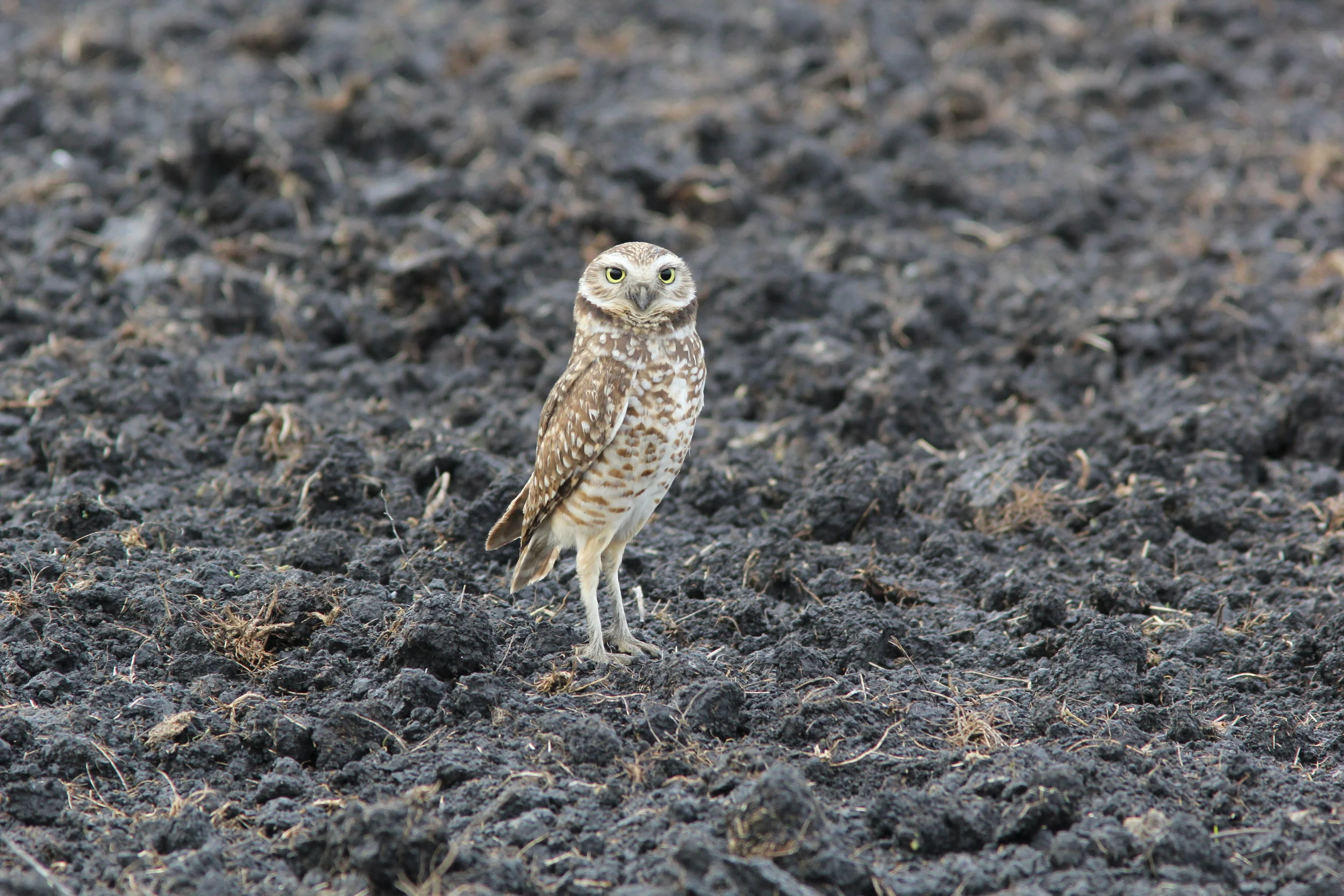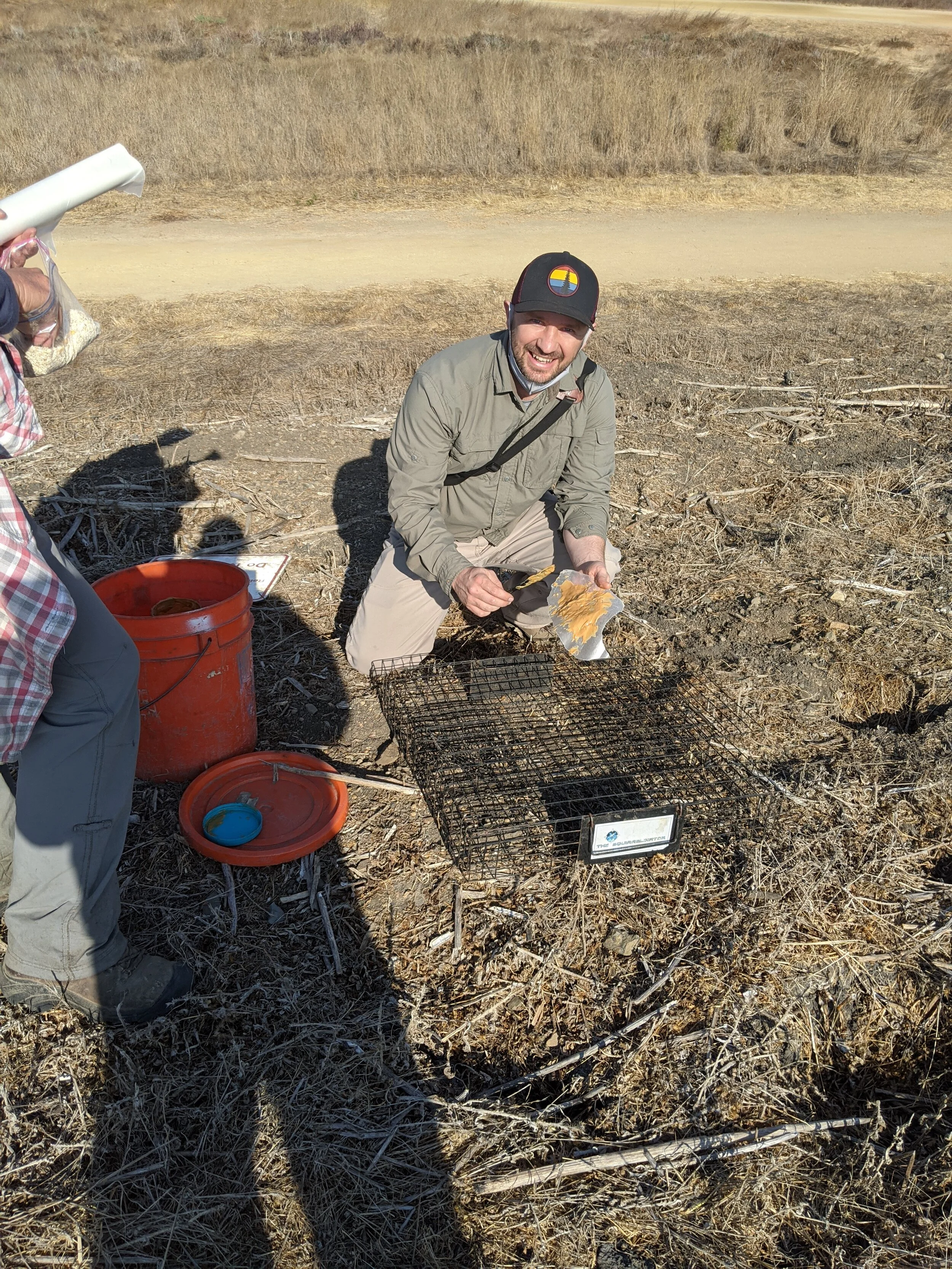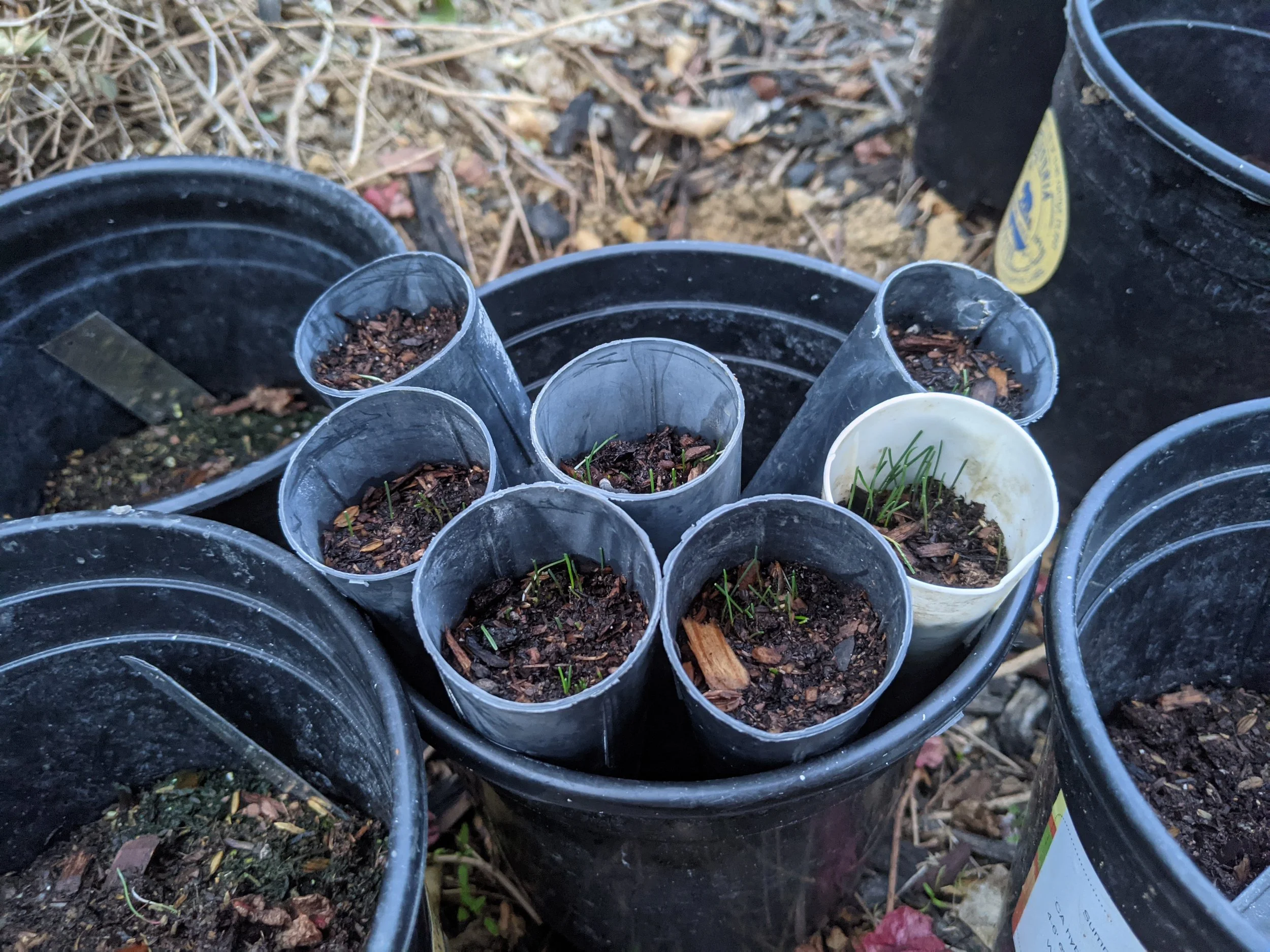Current Project Overviews
burrowing owl Management and conservation
The number of breeding burrowing owls in the greater San Francisco Bay Area has declined precipitously over the past few decades, due in large part to rapid and extensive urban development. Much of the grassland habitat previously occupied by burrowing owls has been paved over, leaving only a remnant mosaic of isolated grassland patches. In this fragmented habitat, burrowing owl colonies have low reproductive success and survival rates. By 2015, only five breeding colonies persisted in the South Bay: Shoreline Regional Wildlife Area in Mountain View, NASA-Ames Research Center at Moffett Field in Mountain View, San Jose International Airport, San Jose-Santa Clara Regional Wastewater Facility (RWF) in Alviso, and the Warm Springs Unit of the Don Edwards San Francisco Bay National Wildlife Refuge in Alameda County.
Starting in 2017, Talon Ecological Research Group has been engaged in burrowing owl management and conservation throughout the Bay Area. We are currently under contract with several public entities for the following projects:
Santa Clara Valley Habitat Agency:
Monthly surveys and habitat management at Don Edwards National Wildlife Refuge – Warm Springs Unit.
Monthly surveys and habitat management at the San Jose-Santa Clara Regional Wastewater Facility bufferlands.
Supplemental Feeding Study: This is a Tier 2 Conservations Action under the Santa Clara Valley HCP/NCCP. Since 2017, we have been feeding burrowing owls during the breeding season to increase reproductive success and survival rates at extant colonies.
Juvenile Burrowing Owl Overwintering Project: For this Tier 3 Conservation Action under the Santa Clara Valley HCP/NCCP, we capture juvenile burrowing owls during the breeding season and keep them in captivity over the winter to increase their chance of survival and subsequent chance for successful reproduction. Overwintered juveniles are released as breeding pairs the following spring. The pairs are selected based on genomic analyses to increase genetic diversity. We have conducted this work annually since 2019.
Captive Breeding Program: In 2021, we initiated a captive breeding program, which is another Tier 3 Conservation Action under the Santa Clara Valley HCP/NCCP. We currently house two captive pairs of burrowing owls that successfully reproduced each year. The offspring is included in the Overwintering Project and released the following spring.
Banding Project: Since 2021, we have been banding burrowing owls during the breeding season.
City of Sunnyvale:
Monthly surveys and habitat management at the Sunnyvale Landfill and Baylands Park.
NASA Ames Research Center:
Under contract with BB&E, we conduct annual breeding season surveys and banding at Moffett Field.
SANTA CLARA VALLEY WATER: SAFE, CLEAN WATER GRANTS & PARTNERSHIPS PROGRAM
Talon Ecological Research Group was awarded the 2022 Valley Water Standard Grant. For this grant, we proposed to enhance native understory vegetation in a riparian corridor and adjacent upland areas along the north-western bank of Fisher Creek within the Landtrust of Santa Clara Valley’s Metcalf Energy Center Ecological Preserve (MECEP). Native vegetation will provide habitat and food resources for native fauna including pollinator species, birds, amphibians, reptiles, and small mammals. Activities will include removal of invasive non-native weeds and subsequent installation/maintenance of native plants. Additionally, we will install nest boxes for cavity-nesting bird species that commonly occur in this riparian corridor, as well as bat and invertebrate boxes. We will recruit volunteers from the local community to help with activities including planting, weeding, trash pick-up, and nest box installation.
Tricolored blackbird monitoring
The Tricolored Blackbird (Agelaius tricolor) is a colonial nesting passerine largely endemic to California. Colonial nesting birds are susceptible to extinction because the majority of the population exists in a few large colonies that require a large prey base and are vulnerable to disturbance. Recent statewide surveys have shown a sixty-three percent population decline between 2008 and 2014, and an eighty percent decline over the last 90 years (Meese 2014). Therefore, the Tricolored Blackbird is a conservation concern of high research priority. The California Fish and Game Commission granted a 180 day emergency “Endangered” listing for the Tricolored Blackbird in 2014, but the status was not extended past the initial period. The Tricolored Blackbird is a species of special concern, but is currently a candidate species for listing under the Endangered Species Act. They are also a covered species in the Santa Clara Valley Habitat Conservation Plan.
The majority of Tricolored Blackbird breeding colonies are found in the Central Valley. However, smaller colonies can be found scattered throughout the Central Coast Range, including Santa Clara County. Records of Tricolored Blackbirdbreeding in Santa Clara County date back to the 1800’s, but were considered to be uncommon and local breeders through the early 1900’s (Bousman 2007). Recent breeding records showa scattered distribution in Santa Clara Valley and the Diablo Range (Bousman 2007) with nesting colonies found at Calero Reservoir (2014, 1989), Lake Cunningham Park (1994), Coyote Percolation Ponds (1983, 1985), Coyote Ranch Park (1994), Del Puerto Canyon Road (2005, 2008, 2010, 2011), and Halls Valley (1982, 1983, 1987) (Tricolored Blackbird Portal 2015).
In 2014, a nesting colony of an estimated 600 Tricolored Blackbirds was discovered at Calero Reservoir. This was the only confirmed nesting colony in Santa Clara County in 2014 (T. Rahmig pers. comm.). This colony used the alfalfa fields in Coyote Valley (2-4 miles away) as foraging grounds for insects, as many flight lines (1-30 individuals) were observed moving between Coyote Valley and the breeding colony (Phillips pers. obs.).
As the only known breeding colony in Santa Clara County and due to the pressures to develop Coyote Valley, the Calero colony affords a key opportunity to better understand Tricolored Blackbird colonial nesting and foraging behavior. Tricolored Blackbirds are also a covered species under the Santa Clara Habitat Conservation Plan making them a research and conservation priority. We began monitoring Tricolored Blackbirds in Santa Clara County in 2015 and conducted an in-depth survey of the Calero Reservoir nesting colony and continue to monitor this colony. With this research we can better understand the needs and requirements of Tricolored Blackbirds in Santa Clara County to better strategize conservation and enhancement efforts for this species.
Swainson's hawk monitoring
The historic range of Swainson’s Hawk (Buteo swainsoni) in California spanned the Central and South Coast Ranges, the southern extent of the North Coast Range, most of southern California and much of the eastern side of the Sierra Nevada Mountain range (Anderson et al. 2007). In 1983, the Swainson’s Hawk was listed as a Threatened species under the California Endangered Species Act following a 1979 statewide assessment by P. Bloom (Bloom 1980), which estimated 350 breeding pairs throughout the state, a 90% reduction compared to historic densities and extirpation from most of its range (Anderson et al. 2007). The listing was justified owing to the dramatic decline in population size, and the loss of breeding habitat. In California currently, Swainson’s Hawks have a restricted breeding range with three genetically distinct populations: Central Valley, Modoc Plateau and Inyo (Hull et al. 2007). The Central Valley population constitutes 95% of the breeding Swainson’s Hawks in California (Anderson et al. 2007). An inventory of California Swainson’s Hawks conducted by the California Department of Fish and Game (now Fish and Wildlife) and the University of California, Davis Wildlife Health Center from 2005-2006 yielded an estimated combined average of 2,081 breeding pairs (94% in the Central Valley), corresponding to a 600% increase in 27 years.
Oological collections confirm that the Swainson’s Hawk was a sporadic breeder in Santa Clara County in the late nineteenth century (Bousman 2007a). Henry R. Taylor, an egg collector, collected two eggs (WFVZ #98178) from a nest in ‘Ferguson’s Swamp’ on 30 April 1889, which is presumed to be a swampy area located along Llagas Creek south of Gilroy in southern Santa Clara County that was adjacent to ranch land (Bousman 2007a). The other oological record (MVZ #5227) was from a nest located near the Berryessa District or North Valley in San Jose, which is between Coyote Creek and the Diablo Mountain Range foothills, on 21 April 1894.
However, more recently it has been considered a rare transient migrant, with no nesting records since 1894 (Bousman 2007a). There have been two summer records, both a one-day occurrence of an immature on 27 July 2002 and an adult on 9 June 1994, in Santa Clara County of Swainson’s Hawks (Bousman 2007a), with the exception of three inexplicable records of nestlings. A nestling with full natal down was found at the Summitpointe Golf Course in the hills of eastern Milpitas on 11 June 1999 and was taken to a rehabilitator. A second nestling, of near fledging age, was found in a pool house in Saratoga 1 July 2005 and a third nestling was discovered north of Tully Road in San Jose on 17 July 2005 (Rogers et al. 2005, Bousman 2007a). As a result of the unusual and unaccountable circumstances of the recovery of these three nestlings in unsuitable breeding habitat, they were not considered by the Santa Clara County bird record compiler, William Bousman, to be conclusive evidence of Swainson’s Hawks nesting in Santa Clara County (Bousman 2007a).
In 2013, William Bousman located a Swainson's Hawk nest in Coyote Valley, San Jose, which represented the first nest in Santa Clara County of the species since 1894. Talon Biologist, Ryan Phillips, along with De Anza College Wildlife Science Technician students monitored the nest 2013 through 2014. Their results were published in the Western Birds Journal. Stephanie Klein, Talon Research Associate, is monitoring Swainson’s Hawks and their expansion in the Central Coast region.




























